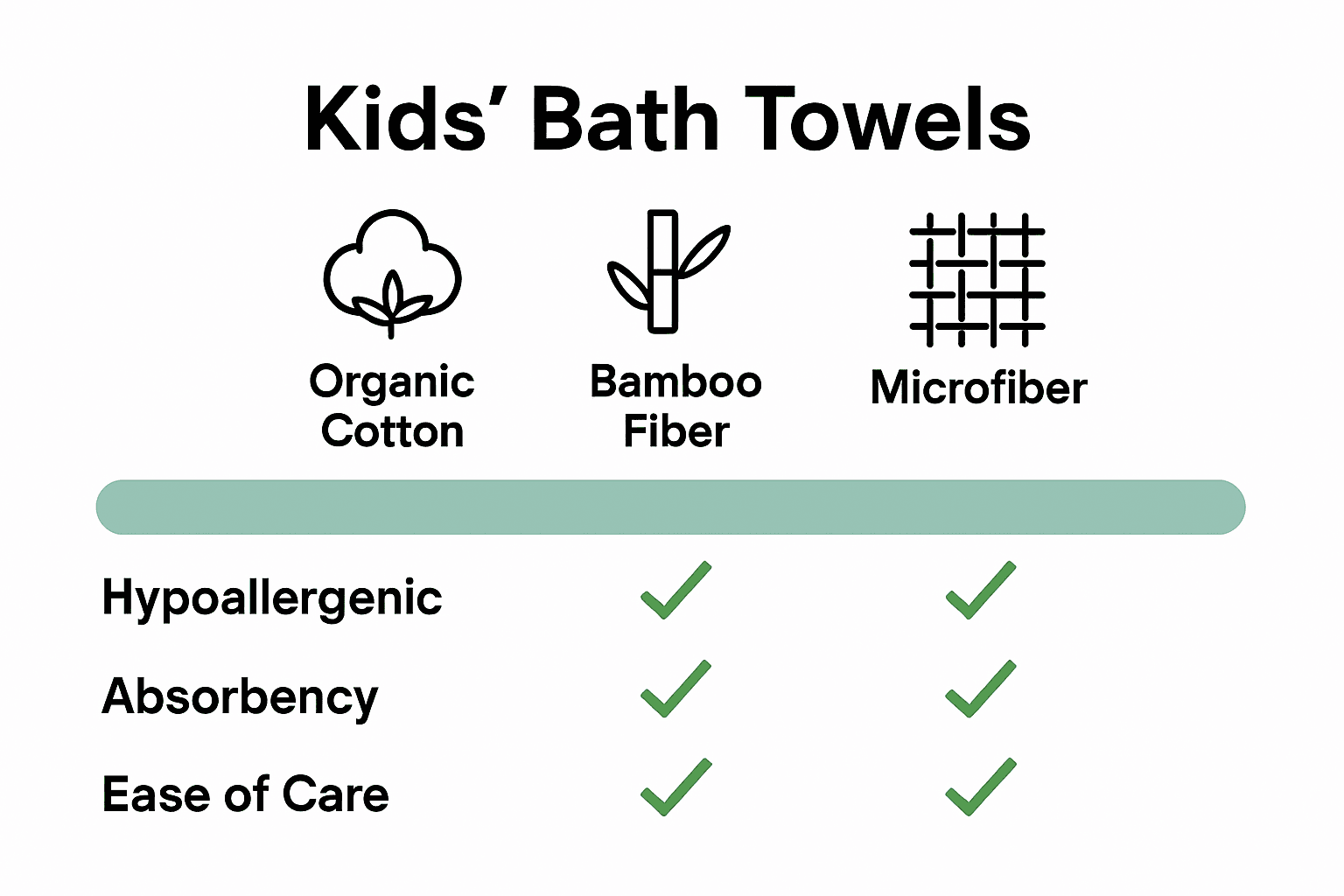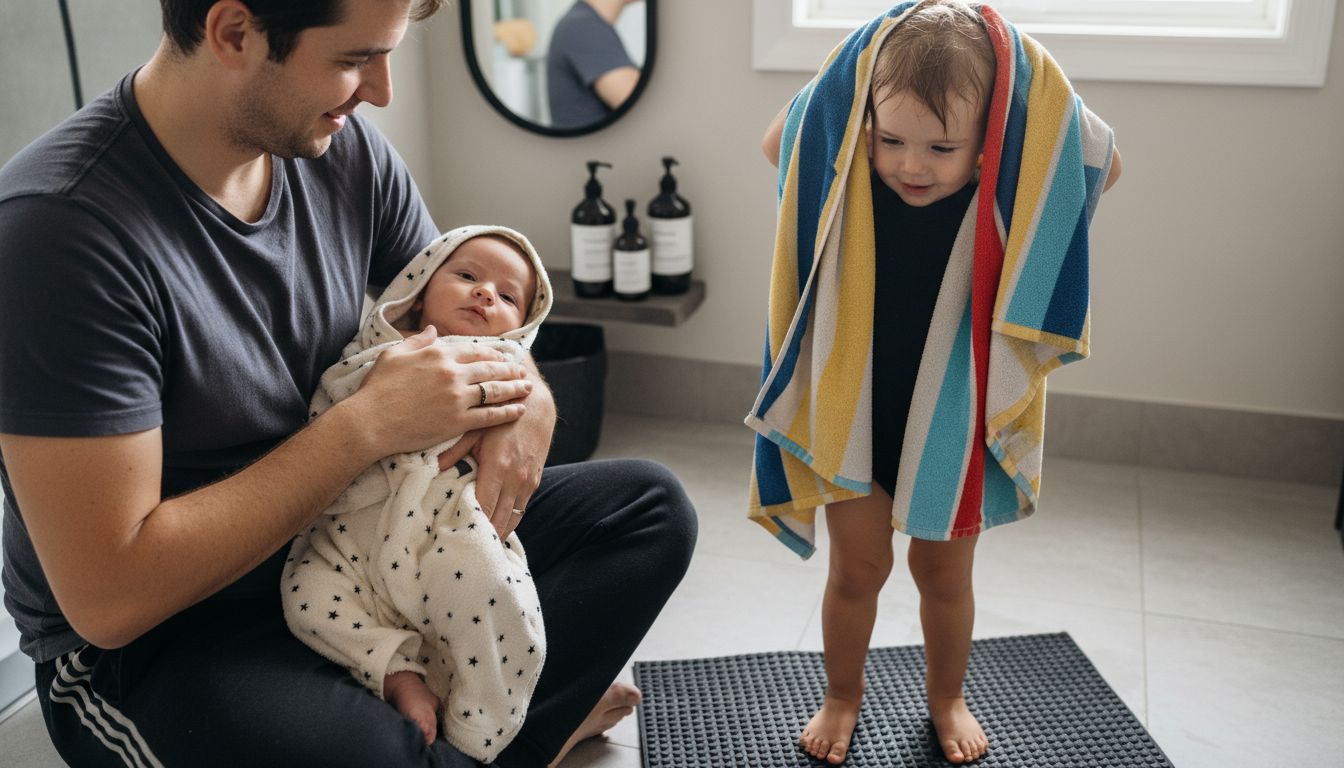Bath time may seem simple, but even a small oversight can carry big risks for young children. According to safety experts, drowning can happen in just 1 to 2 inches of water, which makes every moment in the bathroom count. Choosing the right kids bath towel and using it safely plays a major part in protecting your child from slips, skin irritation, and hidden hazards. This guide explains the essentials so parents can create a safer, more comfortable bath experience.
Table of Contents
- What Is Kids Bath Towel Safety?
- Key Materials and Fabric Standards Explained
- Correct Usage for Different Age Groups
- Preventing Accidents: Choking, Slipping, and Allergies
- Proper Care, Washing, and Maintenance Tips
Key Takeaways
| Point | Details |
|---|---|
| Material Safety | Choose towels made from hypoallergenic and safe materials like organic cotton and bamboo to protect sensitive skin. |
| Supervision is Key | Always supervise children during bath time to prevent water-related accidents and ensure safety. |
| Age-Appropriate Towels | Select towels based on the child’s age to promote independence while ensuring safety, such as hooded towels for infants and fun designs for preschoolers. |
| Proper Maintenance | Regularly wash towels with mild detergents and avoid harsh chemicals to maintain hygiene and fabric integrity for children’s use. |
What Is Kids Bath Towel Safety?
Kids bath towel safety is about protecting children during and after bathing through strategic product selection, proper supervision, and thoughtful bathroom preparation. According to Consumer Reports, drowning can occur in just 1 to 2 inches of water, making bath time safety a critical concern for parents and caregivers.
The core principles of kids bath towel safety revolve around three fundamental elements: material safety, supervision, and practical design. First, towels must be soft, absorbent, and free from harsh chemicals that could irritate a child’s sensitive skin. Second, as Healthy Children emphasizes, constant adult supervision is non-negotiable during bath time, ensuring children remain safe from potential water-related risks.
Key safety considerations for kids bath towels include:
- Choosing hypoallergenic materials
- Ensuring quick and complete body drying
- Selecting towels with appropriate size for easy handling
- Avoiding towels with loose threads or potential choking hazards
- Using quick-dry fabrics to prevent moisture buildup
Beyond the towel itself, safety also involves creating a secure bathing environment. This means maintaining a non-slip surface, keeping water temperature moderate, and having all necessary items within immediate reach.
Key Materials and Fabric Standards Explained
Fabric safety is a critical consideration when selecting kids bath towels, with specific materials and standards designed to protect children’s delicate skin and ensure maximum comfort. According to Consumer Reports, understanding material composition is as crucial as bath safety techniques like maintaining appropriate water temperatures.
The most recommended materials for children’s bath towels include organic cotton, bamboo fiber, and microfiber. These fabrics offer unique advantages: organic cotton provides hypoallergenic protection, bamboo fiber delivers natural antimicrobial properties, and microfiber ensures rapid moisture absorption. Each material undergoes rigorous testing to meet pediatric textile safety standards, which evaluate factors like chemical content, fabric durability, and potential skin irritation risks.
Key fabric standards parents should prioritize include:
- OEKO-TEX Standard 100 certification
- Low chemical processing
- Minimum thread count of 300
- Absence of harmful dyes or bleaching agents
- Soft, non-abrasive texture
Beyond material selection, Learn more about choosing perfect bath towels with our comprehensive guide to understand the nuanced world of textile safety for children. Careful selection ensures not just comfort, but also protection against potential skin sensitivities and allergic reactions.

Correct Usage for Different Age Groups
Bath towel safety varies significantly across different childhood developmental stages, requiring parents to adapt their approach as children grow. Consumer Reports emphasizes that bath safety is not a one-size-fits-all strategy, but a nuanced approach tailored to each age group’s specific needs and capabilities.
For infants and babies (0-12 months), towel usage demands the most vigilant supervision. Parents should use small, ultra-soft towels with maximum absorbency, keeping the child completely supported and never leaving them unattended. Towels should be pre-warmed and immediately wrapped around the baby to prevent temperature shock. Toddlers (1-3 years) require slightly larger towels with increased independence, focusing on designs that are easy to grip and quick to dry.
Age-specific towel recommendations include:
- Newborns: Hooded, extra-soft cotton towels
- Toddlers: Lightweight, quick-dry microfiber towels
- Preschoolers: Larger towels with fun designs to encourage self-drying
- School-age children: Full-sized towels promoting complete independence

Discover more about selecting the perfect robe fit for growing kids with our comprehensive guide, which provides additional insights into age-appropriate bathing accessories and safety techniques.
Preventing Accidents: Choking, Slipping, and Allergies
Bath safety extends far beyond simple supervision, requiring a comprehensive approach to preventing potential hazards that can emerge during and after bathing. Consumer Reports highlights the critical importance of addressing multiple safety dimensions, including preventing slips, choking risks, and managing potential allergic reactions.
Choking prevention starts with careful towel selection and management. Parents should avoid towels with loose threads, decorative elements, or hanging tags that could potentially wrap around a child’s neck or become a grasping hazard. For slip prevention, MedlinePlus recommends using non-skid mats or decals inside the bathing area, ensuring a secure surface that minimizes the risk of accidental falls during and after bathing.
Key strategies for preventing bath-related accidents include:
- Inspecting towels regularly for wear and tear
- Using hypoallergenic fabrics
- Keeping towel edges smooth and free from loose threads
- Installing non-slip mats in bath and drying areas
- Maintaining constant supervision during bath time
Explore our comprehensive guide on selecting the perfect bath towels to understand how material selection plays a crucial role in ensuring your child’s safety and comfort during bath time.
Proper Care, Washing, and Maintenance Tips
Towel maintenance is a critical aspect of ensuring long-term safety and hygiene for children’s bath linens. Consumer Reports emphasizes the importance of regular cleaning to prevent the buildup of harmful bacteria and potential skin irritants that can compromise a child’s health.
Proper washing techniques are essential for preserving the quality and safety of kids’ bath towels. Parents should use mild, hypoallergenic detergents and avoid fabric softeners that can reduce towel absorbency and potentially irritate sensitive skin. Wash towels separately from other laundry, using warm water and a gentle cycle to maintain fabric integrity. Experts recommend washing kids’ towels more frequently than adult towels - ideally after every 2-3 uses or immediately if the towel becomes visibly soiled or develops an unusual odor.
Key maintenance tips for kids’ bath towels include:
- Wash in warm water (not hot) to prevent fabric damage
- Use hypoallergenic, fragrance-free detergents
- Avoid bleach and harsh chemical cleaners
- Dry thoroughly to prevent mold and mildew growth
- Replace towels showing signs of wear or thinning
Learn more about selecting the perfect bath towels with our comprehensive guide, which provides additional insights into maintaining the highest standards of towel care and safety for your children.
Keep Your Child Safe and Cozy with the Right Bath Towels
Bath time safety is a crucial challenge every parent faces. From selecting hypoallergenic materials to preventing slips and choking hazards, you want to ensure your child feels comfortable and protected after every bath. As the article highlights, choosing towels with the right fabric standards and proper sizing can make all the difference in avoiding skin irritations and bath-related accidents.

Don’t wait to provide your family with premium, safe, and soft bath towels that grow with your child. Explore how Lotus Linen offers a curated selection of plush and quick-dry kids’ towels designed for comfort and safety. Learn more about the art of choosing the perfect bath towels and find robes fit for growing kids that combine quality and ease. Take the next step toward worry-free bath time and visit Lotus Linen today to discover products that care as much about your child’s safety as you do.
Frequently Asked Questions
What materials are safest for kids’ bath towels?
The safest materials for kids’ bath towels include organic cotton, bamboo fiber, and microfiber. These fabrics are soft, absorbent, hypoallergenic, and free from harsh chemicals that could irritate a child’s sensitive skin.
How often should I wash my child’s bath towels?
Kids’ bath towels should ideally be washed after every 2-3 uses or immediately if they become visibly soiled or develop an unusual odor. Regular washing helps prevent the buildup of harmful bacteria and skin irritants.
What size towel is best for toddlers?
For toddlers, lightweight, quick-dry microfiber towels that are easy to grip and slightly larger in size are recommended. This helps promote their growing independence while ensuring they can dry off comfortably.
How can I prevent accidents during bath time?
To prevent accidents during bath time, ensure constant adult supervision, use non-slip mats in the bathing area, choose towels without loose threads, and maintain a safe water temperature. The towels should be easy to handle and fully absorbent to avoid slips and falls.
